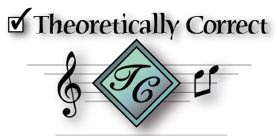A Brief History of
Music Transcription Tools
— Return to article and review on Transcribe —
Phonograph turntables & variable-speed cassette players
I've been learning music by ear since 6th grade. I got serious deeply into it in college, learning Leo Kottke guitar pieces and studying old-time fiddle and bluegrass fiddle. I began notating practically everything I learned.
In total, over the years, I spent roughly $1600 on analog equipment that slowed down the recordings. Today you can get a much better deal for $50, nevertheless, here's my recount of equipment and costs for slowing down music in the 70's 80's and 90's.
Between 1976 and the mid-90s I spent about $1200 on Marantz (i.e. Superscope) variable-speed tape recorders. Learning by ear and transcribing requires constant rewinding, and that was pretty hard transport mechanisms—I wore out three of these expensive cassette players in about 12 years.
Before using cassettes I transcribed with a Swiss made $400 Lenco variable-speed turntable.
My total investment for transcribing equipment:
- Cassette decks and turntable: $1600
- The number of vinyl records destroyed? Unknown $
Comparatively speaking, at $50, Transcribe is a great deal! Analog tools like turntables or cassette players were so much harder to use, there was always pitch shift to contend with, and it was really hard to review and find your way around the recording.
Transcribe solves all this and offers dozens of features that ease the task of finding, isolating, looping and reviewing sections of the music.
Turntables
Phonograph turntables were cumbersome in so many ways. Setting the pitch on a variable-speed phonograph turntable was a regular project . First of all, you could only guess. Zeroing in was a test of your marksmanship — the slightest nudge of the pitch dial and you'd overshoot, and it was impossible to quickly return to previous setting. Once you got the pitch right, then you had the arduous task of delicately lifting and resetting the needle so you could here the section a few times. And with the slightest sideways movement, you'd scratch the vinyl and create a series of permanent pops.
Cassettes
When variable-speed cassette players became available I immediately switched to those. They were so much easier to use than turntables. We had to record vinyl or CD tracks onto a cassette, keep a library of those on hand, catalogue the order of tracks and fast forward through the cassette to find the desired track—all very time consuming. But now at least it was easy to rewind, listen to sections repeatedly, and play along over short sections.
Analog speed control
For decades, musicians worked with speed and pitch inseparably intertwined. When you slowed playback on an analog device the pitch changed accordingly. Say you wanted to slow the speed to 75% the pitch would drop an augmented 4th. If you wanted to play along, you'd have to play in a key a 6 half steps lower, or retune your instrument if possible. But hardly anybody did that. Instead the favorite trick was to play along at half-speed. This lowered the pitch an entire one octave so musicians could play along at the distance of a perfect octave above. This "half-speed" trick has been in use since the early days of recorded music. People used to play 33 RPM phonograph LPs at 16 RPM. Later came reel-to-reel and cassette decks that offered half-speed playback, then cassettes.
Even though half-speed approach was the simplest, most manageable method available, there some big disadvantages. With the speed set to 50%, the pitch dropped a a FULL octave. Sometimes it was hard identify instruments an full octave out of range, because their timbres were drastically altered. For instance a violin sounded like a cello. With pitch lowered an octave, the bass is so deep it's practically imperceptible. Guitar chords sound like someone's strumming on a bass guitar! It was easy to confuse octaves when transcribing or learning by ear. In a distinctly elephantine way, the music just sounded rumbly and grumbly overall. It wasn't a pleasant experience ... but that's all that was available.
To experience this yourself, get the Amazing Slow Downer trial, or with your registered copy of the Amazing Slow Downer, go to Preferences/Audio and check 'Pitch change affects speed.' When you click OK you'll see that Amazing Slow Downer's speed slider is disabled.
With Amazing Slow Downer configured this way, pitch and speed are intertwined, just like in the old days. It provides a peek into the past. A change in pitch alters the speed of the playback. (We used to think of it in reverse though. Our goal was to slow the speed and we'd notice that the pitch changed. Whatever the case, by moving the pitch slider in slow downer you experience the analog affect of changing the speed of a recording. Increasing the speed 'munchkinizes' the sound producing a 'chipmunk' effect on vocals. Slowing the speed creates a Darth Vader effect.)
Fortunately, we've got better tools now. Way better.
— Return to article and review on Transcribe —
